
Serge Attukwei Clottey hung two structures made from plastic gallon bottles inside and outside the Arsenale. Photo: Veronica Simpson.
Various Venues, Venice
20 May – 26 November 2023
by VERONICA SIMPSON
Is there a right place to start your visit to the Venice Architecture Biennale? How do you choose between the two main venues, a 15-minute walk apart, or the various additional “collateral” events? This year, I feel lucky that my visit begins in the Arsenale, because it offers a multisensory but coherent steer into the enormous range and ambition of this year’s curatorial vision, from the Scottish-Ghanaian architect Lesley Lokko. Unlike the pick-and-mix experience of the Giardini (in which each country exercises its own selection criteria in its national pavilion), once you enter the endlessly elongated, ancient hall of the Arsenale, you are experiencing this year’s theme “The Laboratory of the Future” in the manner Lokko and her team intend. It is a sensual, richly toned and textured, immersive experience, filled with wonderful words as well as sound and a greater range than usual of visual elements; some have criticised this year’s show for being light on architecture. But, in this venue, I find it hugely compelling.
Real care is taken over the visitor’s journey, with a skilful layering of texture, light, mood and music that underpins a sense of being transported into a different realm – the global south, predominantly, given Lokko’s bold vision this year to prioritise projects from this geographic region, one that is normally hugely under-represented in architectural exhibitions. More than 50% of the exhibitors are from Africa, or its diaspora.
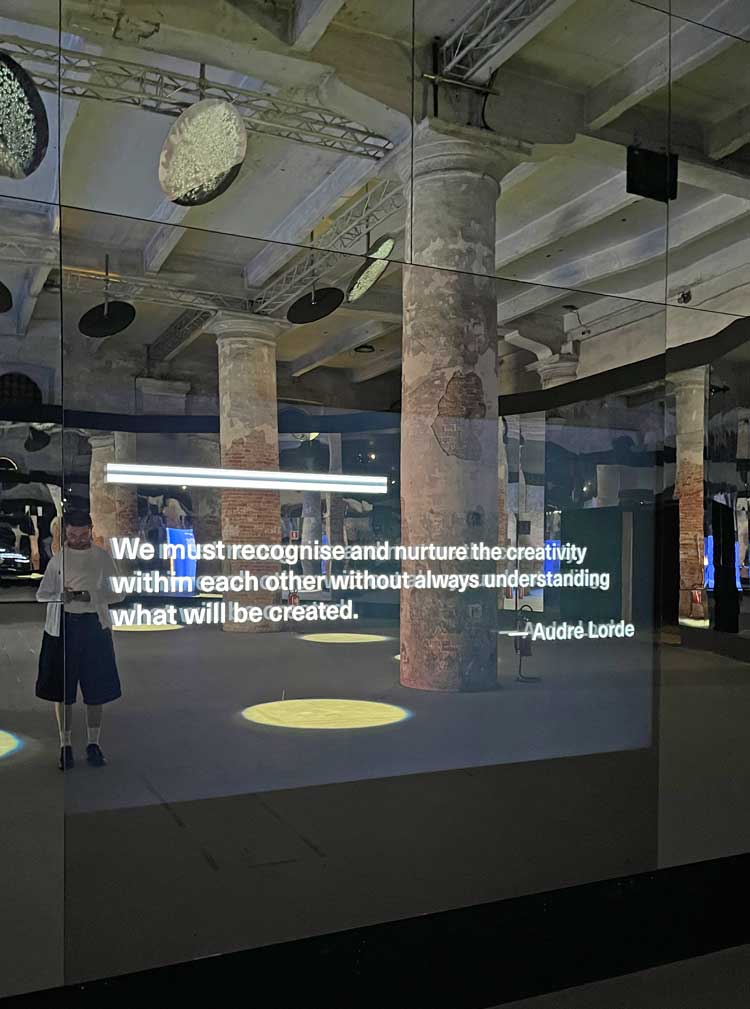
Venice Architecture Biennale 2023: The Laboratory of the Future. Photo: Veronica Simpson.
The beams of multiple spotlights create circles of white light on the floor just beyond the intensely blue-toned entrance lobby, reinforcing the idea not just of transportation but teleportation. And, like the architect/novelist she is, Lokko has composed some choice words to guide us on our journey. In silver script against the blue, she invites us to enter “The Blue Hour”, a “period of time just before sunrise or sunset … (when) the landscape is wrapped in a muffled and suspended atmosphere”. In this period, she says, colour contrasts “that would otherwise be invisible” are seen more clearly. “The blue hour is sometimes marked by a subtle melancholy, or a moment between dream and awakening. It is also considered a moment of hope.”
My mood suitably enhanced, and full of curiosity, I prepare to encounter this year’s curatorial investigations into decolonisation and decarbonisation. The decolonisation, pivoting away from Europe and the US, is joined by a demographic decolonisation, too, away from the dominance of older, bigger, more established architects, with many young and emerging practices selected over the old guard.
As I approach the first installations, more poetic thoughts are beamed towards me, as guidance: “We must recognise and nurture the creativity within each other without always understanding what will be created,” according to the writer Audre Lorde.
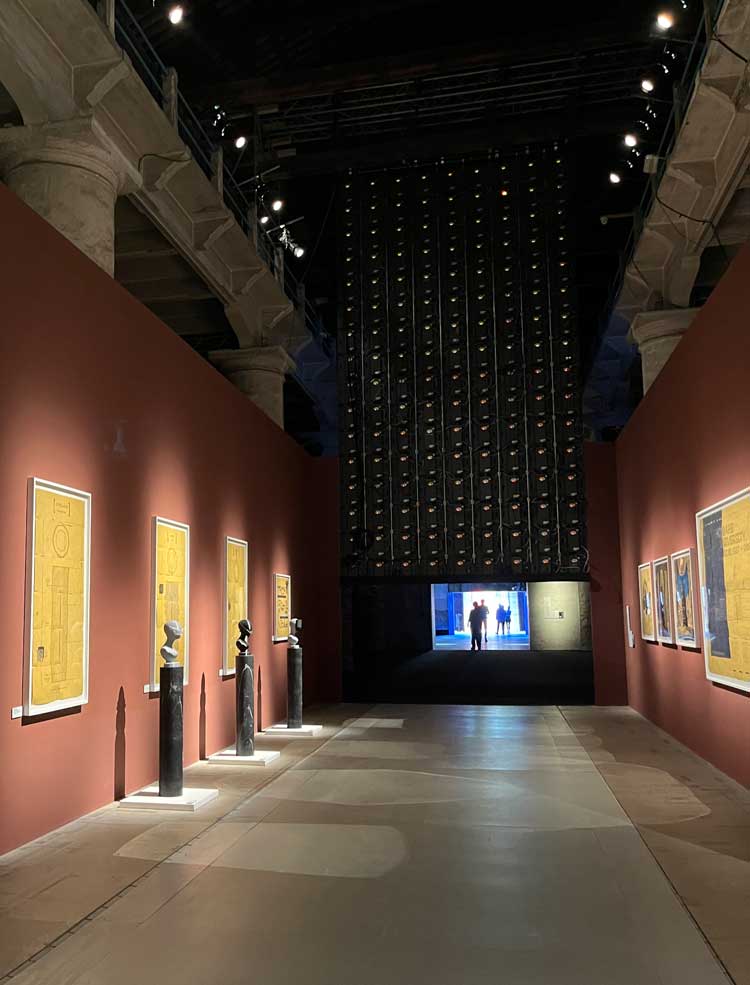
Temple-like Griot installation by Studio Barnes. Photo: Veronica Simpson.
A spirit of change is strikingly apparent, flagged up by the joyful sound of black musicians and dancers in the film projected over the first hall’s doorway. It is reinforced as we enter a kind of temple, complete with robotic, futuristic and decidedly Nubian heads on plinths, and striking illustrations on the walls. A mysterious, monumental marble pillar awaits us in the near distance. This installation, Griot by Studio Barnes, aims to present us with “missing legacies prevalent in the foundational architectural canon”. These heads have been digitally drawn and collaged before being placed atop their marble plinths. The caption tells us that the mottled stone block at the end of this procession is an “identity column”, sculpted from black marble using digital and analogue processes and claiming to offer a “full-scale representation of diasporic lineage, culture and materiality”. That seems quite a tall order for a block of marble, although it certainly has an imposing presence in this earth-toned hallway.
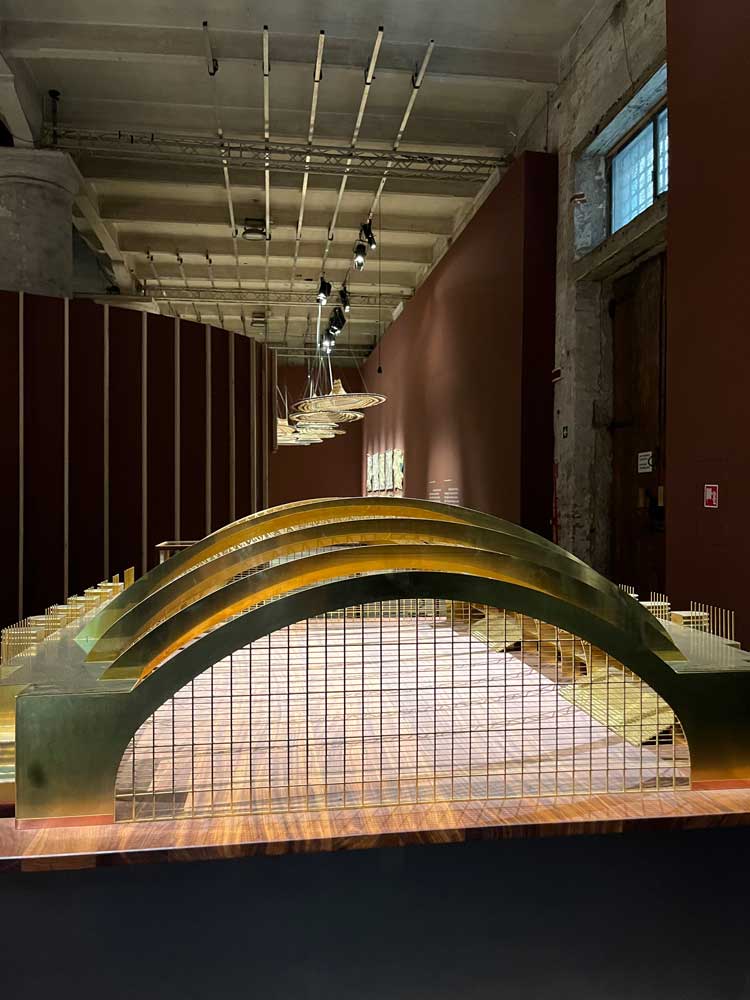
The Extracted Pavilion, 2023 by Sammy Baloji and Twenty Nine Studio. Photo: Veronica Simpson.
To the right of this column is a gleaming copper and brass model. The Extracted Pavilion (2023), by Sammy Baloji and Twenty Nine Studio, is a three-storey vaulted structure, on whose fictional balconies are written the names of materials extracted from Africa by its colonising powers – silver, palm oil, ivory, cobalt. It is one element in Baloji’s installation The Future that Never Was, recreating from Belgian archives a proposal from the architect Henry Lacoste for the 1935 World Fair to celebrate extractive practices in the Belgian Congo – now the Democratic Republic of the Congo (DRC) – the country’s colony from 1908 to 1960. A powerful documentary film screened in the adjacent room gives us a haunting “before and after” scenario, zooming in on Belgium’s investment in Congolese rubber plantations and large-scale production. The film collages emotive scenes of great industry and skill from the early 20th century and now; it segues between Congolese men in crisp shirts and neatly pressed trousers inputting instructions into machine-room control panels; shows us factories and workers’ housing emerging in the forests, but mixes in scenes from more recent times - aerial views of these factories and houses, now overgrown with vegetation, their roofs caved in. The rubber workshops are still in use, it seems, but there are just one or two workers manually manipulating tools and materials in dusty, barely lit workshops.
From this room, we can hear an imam calling the faithful to prayer. That soundtrack emanates from Drawing Memory Into Being, an installation by Office 24-7 and Lemon Pebble Architects. It is a memorial to the Malay Muslim community of South Africa: invited to work in the diamond mines of Kimberley from 1871, they established a thriving community, called Malay Camp, which was subject to forced “‘slums clearance” between 1939 and 1960.
As part of their installation, there is a coiling structure of slender ropes and beads dangling from rooftop to floor - intended as a “ghostly ruin”, but also a “space of prayer”. Facing Mecca, it invites us to “worship without boundaries”.

Textiles showing ancient Amazonian cities revealed by LIDAR technology. Photo: Veronica Simpson.
This is one of several enjoyably tactile, sculptural, textile works, from exotic rope lampshade-structures hovering beside 10 pale but mysterious, runic embroidered textiles. I am beginning to think there are as many artists represented in this architecture biennale as there are architects (an impression later compounded). But I find these textile interventions intriguing, especially when I discover that the embroidered drawings have been created by an assortment of Amazonian textile artists to conjure ancient and hitherto unacknowledged mega cities of the Amazon, the outlines of which have only recently been revealed by light detecting and ranging (Lidar) technology used in 21st-century gold prospecting.
There are also large textile interventions dotted around the place, as well as one made of concrete and glass, Guarda do Embau, dominating a wall between two halls. It has been conjured, we are told, by a “transnational alliance between Brazil, Brussels and New Haven, USA” thanks to Brazil’s Gloria Cabral (whose practice is all about repurposing construction materials), the aforementioned DRC- and Brussels-based artist Baloji and the American art historian Cécile Fromont. The wall caption calls it a “transmedial structure in which construction debris and bricks made of mining waste from Congo’s former metropolis – Brussels - form ornamental patterns echoing the architectural textiles of the historical Kongo kingdom, as well as their Brazilian indigenous cognates”. It is embedded with shards of coloured Venetian glass, evoking centuries-old global connections of extraction, including Venice’s own part in trading beads for slaves.
Beyond, there is a documentary on the work of the Senegalese engineer Doudou Deme who, after training at CRAterre in Grenoble, returned to Senegal and set up his company Elementerre in 2010 to source and market ecological building materials such as compressed bricks and other biomaterials. He has clearly had an impact, supplying projects by local and global architects such as David Adjaye and Frances Kéré of Kéré Architecture. The documentary, Bunt Ban, is by the film director Chérif Tall.
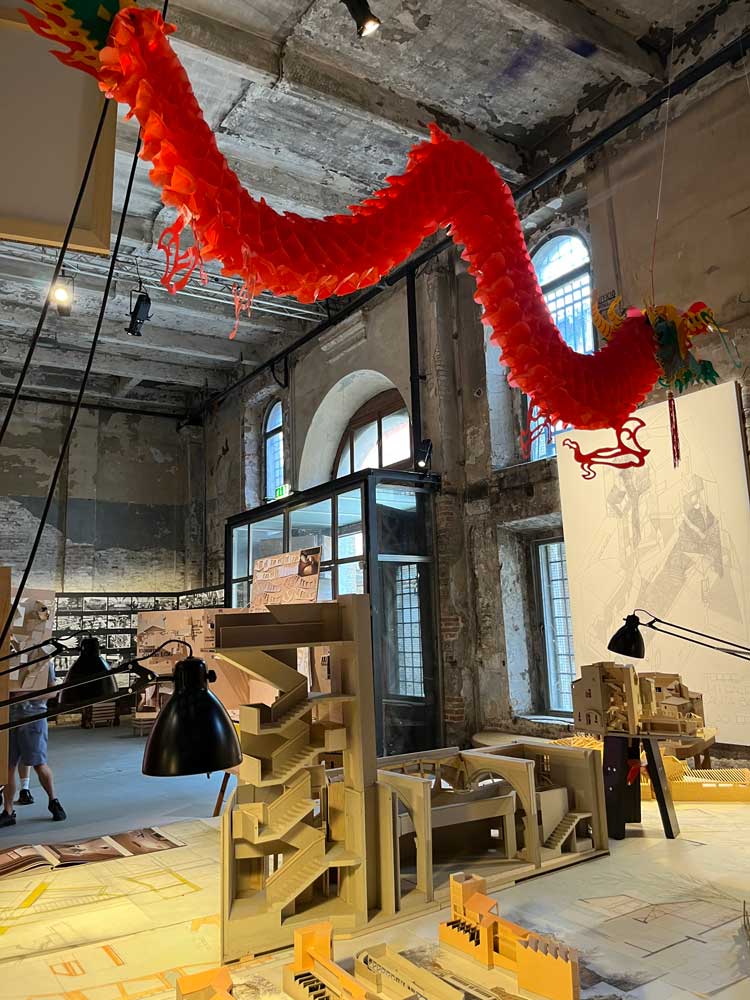
Theatrical exuberance in Flores & Prats’ installation Emotional Heritage. Photo: Veronica Simpson.
So far so inspiring: we are being invited to consider not just what architecture is but what it does, who it is for, and how it affects us all. And that human perspective is beautifully evoked in the Barcelona-based architects Flores & Prats’ installation, Emotional Heritage, which fills a large section of the Arsenale. Accompanied by whimsical, upbeat and lilting music, we have entered a magical kind of workshop, one filled with models placed on worktops and tables around us, in cross section. Each one reveals people as well as miniature furniture, relating instantly the imagined life in these rooms, past and future. Half-finished drawings billow over one structure. Against the wall, smaller models stand sideways, mounted on poles, as though they may suddenly be deployed in a shadow play. Even the desk lamps seem animated, as if about to burst into some captivating choreography. Most magical of all, small projectors play scenes on each model, scenes of the life that has been or might be lived in these buildings.
It articulates, better than any other installation I have seen, that architecture is an act of imagination, but also a conjuring of community. Architecture at its best is truly imagining another world.
Thus far, the works have been staged beautifully to dialogue with the Arsenale in all its glorious scale and texture: the rough walls, the ancient timber trusses, the huge structural columns playing a sensual counterpart to the classic architectural materials of paper, timber, wood, rope and woven cloth. Colour lures us on in our visually rich, thematically complex journey, including regular interludes of glowing red plastic strips dangling from the doorways, separating one section of the Arsenale from the next.
Then we move into worlds that have been imagined much more darkly.
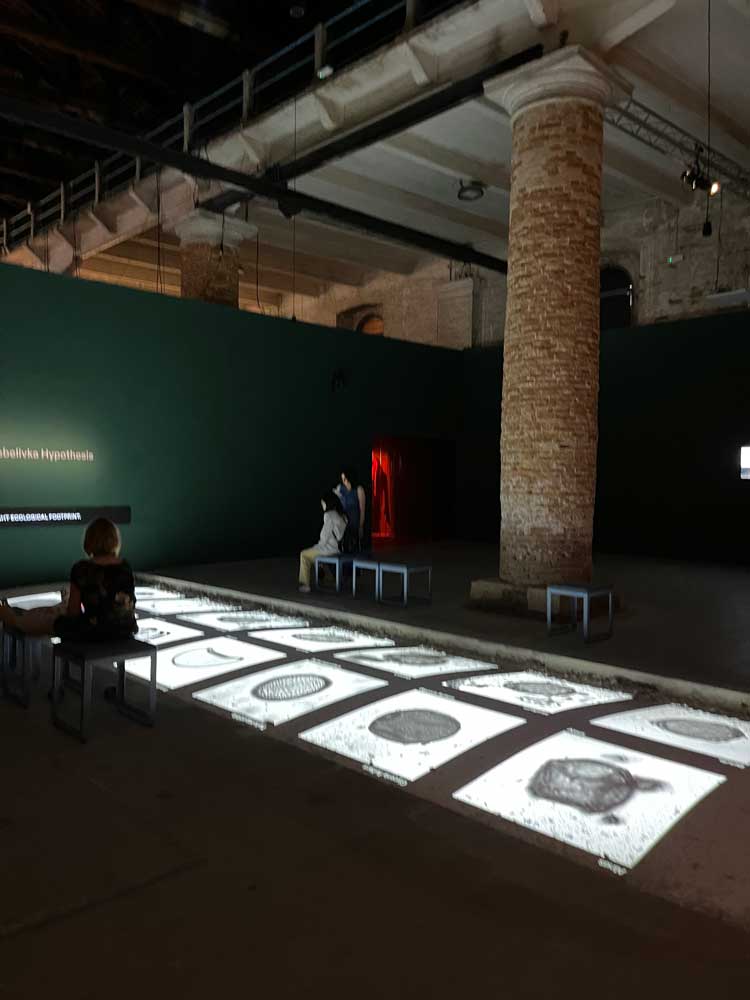
Forensic Architecture, The Nebelivka Hypothesis. Photo: Veronica Simpson.
Forensic Architecture has excavated an oblong at the centre of its Arsenale section in which to describe the deep archaeology of its project, The Nebelivka Hypothesis. It argues that former civilisations are not just evident in structural remnants, but in the soil itself. They have found evidence of a 6,000-year-old settlement in earth less than a metre below the fields of a Ukrainian village called Nebelivka. They want us to understand that the erasure of lives, of civilisations doesn’t just involve buildings. The text reads: “If Nebelivka is a city, then our genealogy of the city – rooted in extraction, predation and hierarchy – must change.” The black-and-white projection that fills this excavated trench in the Arsenale is both menacing and mesmerising.
Synthetic Landscapes is a visually bright but topically dark multiscreen installation by Stephanie Hankey (UK born, Berlin based), Michael Uwemedimo (born in and works in Nigeria) and Jordan Weber (born in and works in the US). It is a semi-real, semi-futuristic video work revealing the toxic after-effects of centuries of extraction. It lays out the trail of evidence – from the aforementioned Venetian beads being traded for humans, to other kinds of “dark cargo”, coal, palm oil and now crude oil. We’re told: “The oils that contaminate or deplete the soil flow north; the soil left behind is carbonised and cannot be remediated – only removed, contained, moved and moved again.”
There is a lot of filmed content across the biennale – Lokko has said that film has been prioritised as a medium to keep the carbon footprint low, but the upshot is that you can feel somewhat overwhelmed in sections where the ratio of moving image to any more tactile alternative is high. There is only so much of our time we can be expected to give up (given the quantity of work on show) to listen endlessly to people talking about architecture. Unsurprisingly, those films that work best are often those that are not by or about architecture, such as the artist Ursula Biemann’s film Devenir Universidad (Becoming a University), made with and about the Inga people of southwest Colombia. Biemann has been working with this community since 2018, to try to establish an alternative university – one in which indigenous wisdoms, knowledge and practices can be harnessed to reverse biodiversity loss, cultural extinction and the damage caused by extractive capitalism.
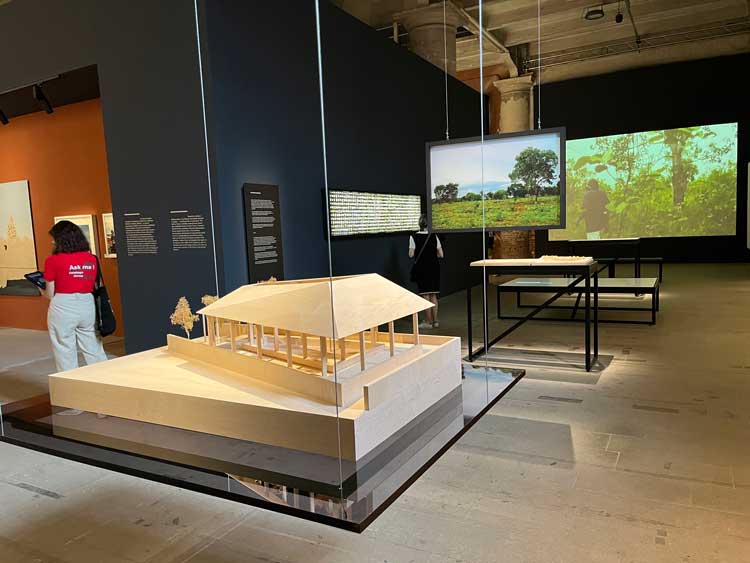
Rashid Ali Architects, courtyard pavilion, Hargeisa, Somaliland. Photo: Veronica Simpson.
Lokko, in her Curator’s Special Project selection, has highlighted certain “Guests from the Future” in the Arsenale, presumably to point towards a better use of architectural skills. One of these is Rashid Ali Architects, which, although London based, has been working in East Africa in the city of Hargeisa, Somaliland. There is a model of a delightful courtyard pavilion that the practice has conjured for this community. It is one of a city-wide proposal of structures and spaces that might better knit together the urban fabric.
From this upbeat moment, I arrive at architect Alison Killing’s documentary: a kind of crime scene investigation project with a particular architectural typology as incriminating evidence. From looking at satellite photographs across Xinjiang province, she found evidence that the Chinese authorities were building containment camps to detain and ultimately displace its Muslim Uyghur population, more than a million of whom are believed to have vanished in this way. Her efforts took a turn for the weirder when she and her investigative cohort realised that the authorities were digitally dematerialising the evidence.
After this, and chilling accounts from some of the dispersed (but now, thankfully, relocated) Muslims, it is a relief to find something a little more positive in a textile triptych by Arinjoy Sen, Bengali Song. She made the work in collaboration with the SHE Kantha Collective in Bengal, to imagine “planetary survival by prioritising respect between diverse ecologies and people”. The work “positions the architect as giving voice to marginalised peoples”.
I am pleased, just a few steps further away to find myself in a room full of large-scale models – Co-living Courtyard by China’s ZAO/standardarchitecture. It shares ideas from three active projects to encourage conversation on how to make active, engaged, co-living communities rather than the current situation which encourages a “drifting apart, physically and anthropologically”. However, after witnessing Killing’s film on China’s “disappearing” act on the Uyghur community, it leaves a nasty taste in my mouth – as does the fact, flagged up in other biennale reviews, that China has been one of the most powerful extractive forces on Africa since individual countries shed the shackles of their European colonisers, and it still is: embedding its workforces (and chalking up masses of debt in its favour) in the creation of the continent’s infrastructure. There is no mention of that – of course.
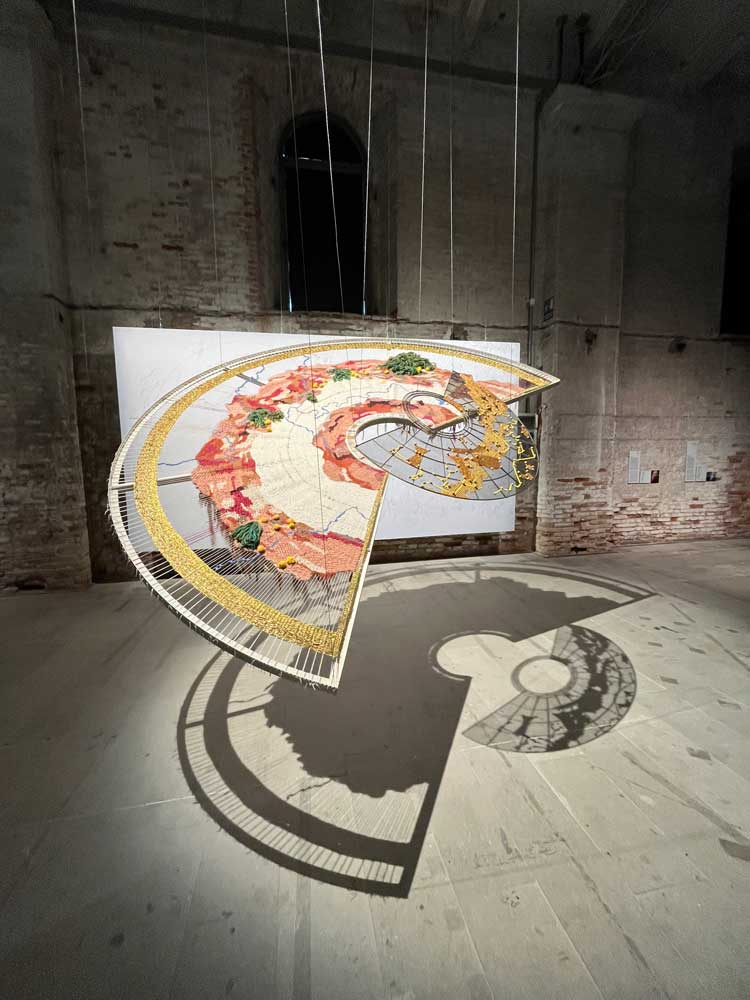
Workshopping the Chattahoochee by SCAPE Landscape Architecture. Photo: Veronica Simpson.
Moving on swiftly, there is a wonderful, diagonal sculpture slicing through the air: Workshopping the Chattahoochee, by SCAPE Landscape Architecture. It represents four decades of community “planning, remediation and grassroots environmental justice advocacy” … to reconnect the Chattahoochee River to the city of Atlanta via 125 miles of park walkways, bike lanes and trails between downtown, suburban fringe, agricultural fields and forests.
When you need a breather, you are never too far from escape in the Arsenale, with multiple exits allowing you to take a detour out of the long, dark hall to be by the lapping waters of the lagoon. Here we can admire Adjaye’s poetically porous structure and the seemingly delicate, yellow patchwork blanket hung from one of the external boatyards, which turns out to be made from squares of plastic snipped from gallon bottles, the material of choice of Ghana’s Serge Attukwei Clottey, one of two iterations in this biennale from his Afrogallonism project.
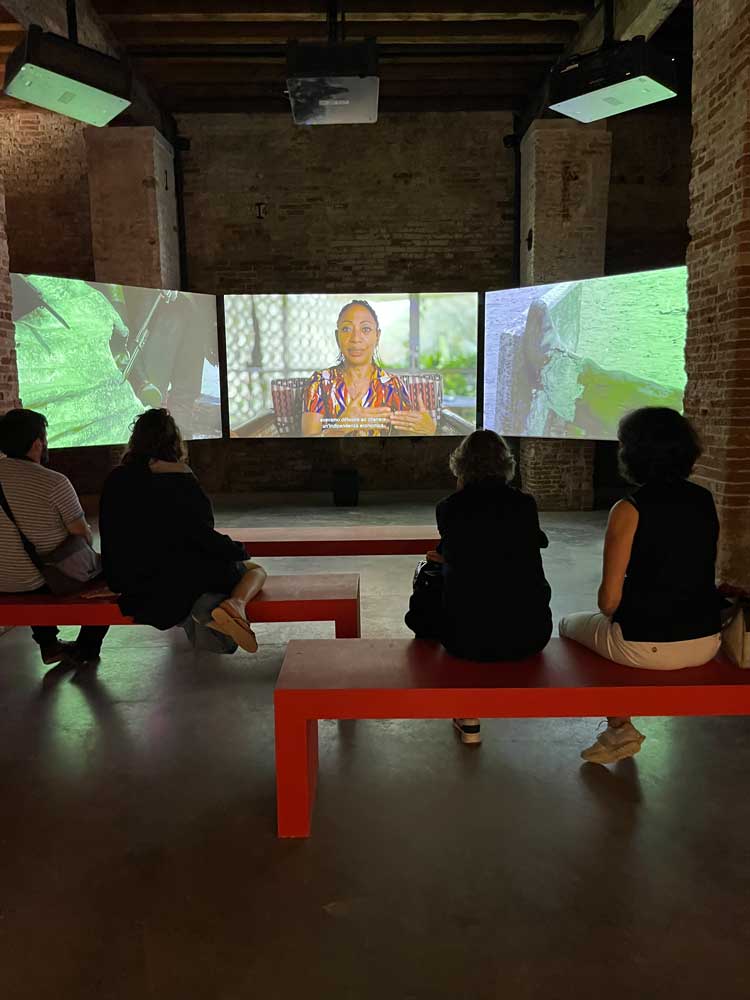
V&A’s installation, Tropical Modernism: Architecture and Power in West Africa. Photo: Veronica Simpson.
In one courtyard, I also really enjoy the V&A’s installation: Tropical Modernism: Architecture and Power in West Africa. Documentary footage takes us to peak post-independence Ghana, and president Kwame Nkrumah’s desire to build his new nation with the latest architecture. He enlisted various tutors and students from the Architectural Association (who created a Department of Tropical Studies to make the most of this and other possible avenues in the former colonies) to create a university campus, Kwame Nkrumah University of Science and Technology (KNUST). From the three-screen footage here, it shows a campus far bolder and more modern than any equivalent in the UK, but the project almost bankrupted the country, and this and other construction projects stalled after Nkruma’s deposition by coup in 1966. Although leading Ghanaian architects emerged from this school – among them John Owusu Addo – the film questions the appropriateness of the modernist, concrete constructions in that culture and climate, and the legacy of these collaborations.
Ultimately, I leave the Arsenale wanting to hang on to the feeling that this could be the best architectural exhibition ever, because it is architecture at its essence: as a form of spatial practice that cannot or should not be detached from its site, its ends or its occupants.
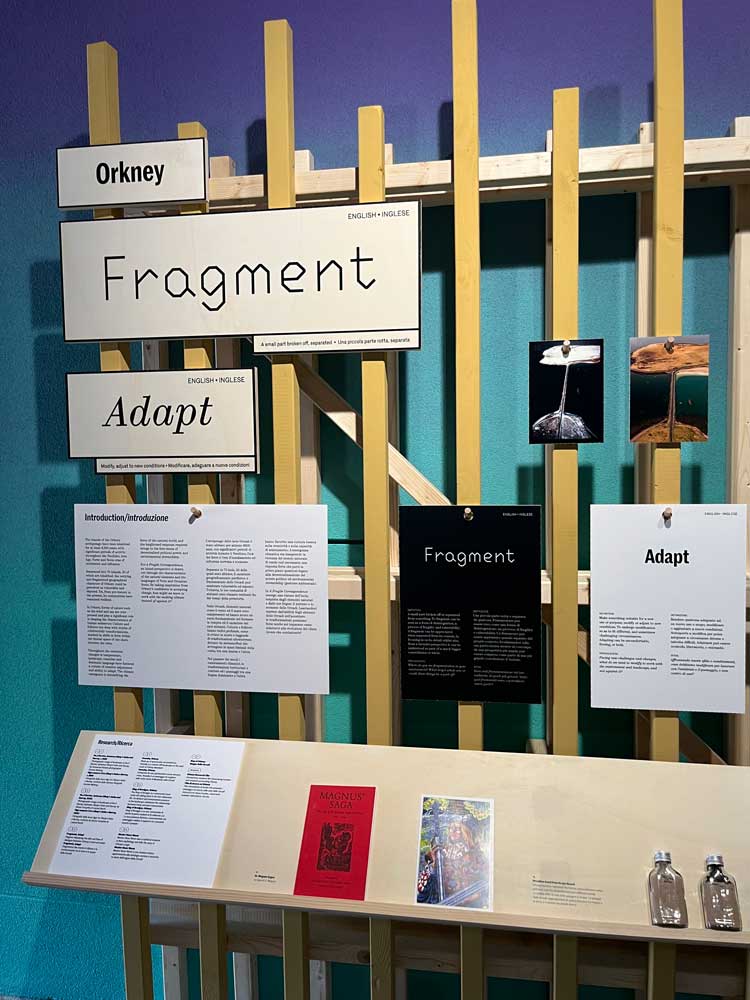
Scotland in Venice looking into the language of place. Photo: Veronica Simpson.
However, another day, another dive into the biennale, this time the Giardini, but with a sideways start in the boatyard just around the corner from the Giardini, where Scotland in Venice has spent the last few biennales. With the canal gently lapping alongside the installation, it is a delightful place to contemplate the power of language, as a way of connecting with the land and its people. Through documentary interviews, objects, archive material, sound and the inspired, evocative settings, we are taken into three specific landscapes, three communities – in the Highlands, the Islands and the Lowlands – and into what felt like a much older and more authentic relationship with place.
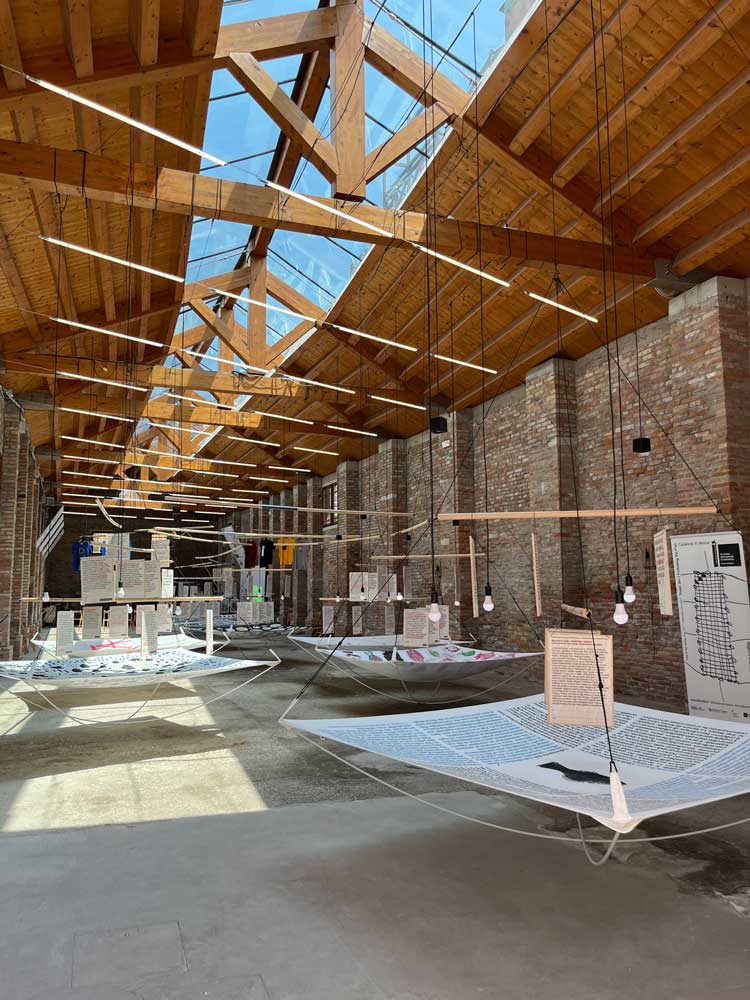
Catalonia creates an inviting space looking at the role food plays in bringing diasporic communities together. Photo: Veronica Simpson.
Catalonia’s offering, opposite Scotland’s, conjured a wonderful sculptural evocation of specific migrant communities in Spain and what binds them together – mostly adapting existing structures and connecting with each other through food.
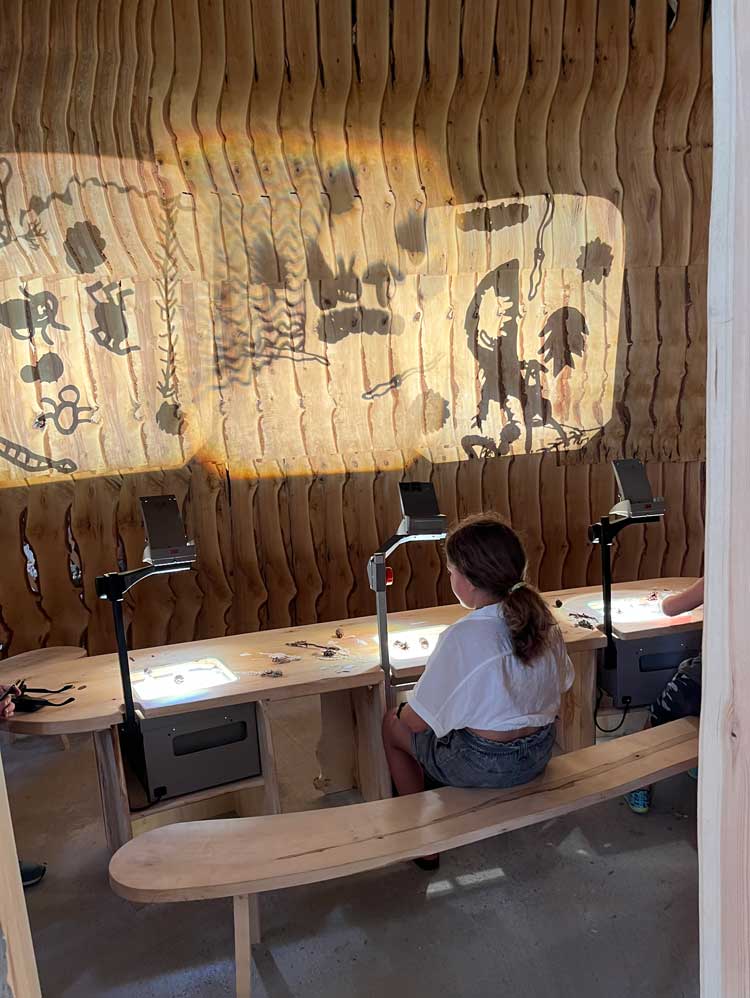
Lithuania invites us to pay closer attention to nature through this forest-inspired pavilion of play. Photo: Veronica Simpson.
Lithuania’s pavilion offers a garden of delights, of play, specifically child-centred, but also charming the child in all of us. Its staging evokes forest strolls and offers enticements for closer investigation into what is under our noses in nature.
Things became more problematic when I arrive in the Giardini, to the scattergun approach of the national pavilions. The British pavilion does a wonderful job of conjuring specific diasporic communities, but it does not say anything about the physical structures that support or thwart their lives.

Germany’s pavilion, The Material Repository. Photo: Veronica Simpson.
Germany’s pavilion, boldly continuing with the deconstructed walls and floors from last year’s Art Biennale intervention, offers a wonderful assemblage of discarded materials from previous years and, what’s more, real people in workshops making things out of them, via The Material Repository.
Brazil’s offering, Terra, by Gabriela de Matos and Paulo Tavares, is powerful and fully deserves its Golden Lion award. The pavilion is filled with soil and structures that evoke the traditions of the indigenous people and the quilombola (black slaves who resisted the slavery regime that existed in Brazil for more than 300 years), to highlight that these territories are the most preserved in Brazil, and that a post climate-change future could be achieved through continuing their ancient practices of land management. Its soft colourings and soil-scented warmth make the pavilion a pleasure to inhabit.
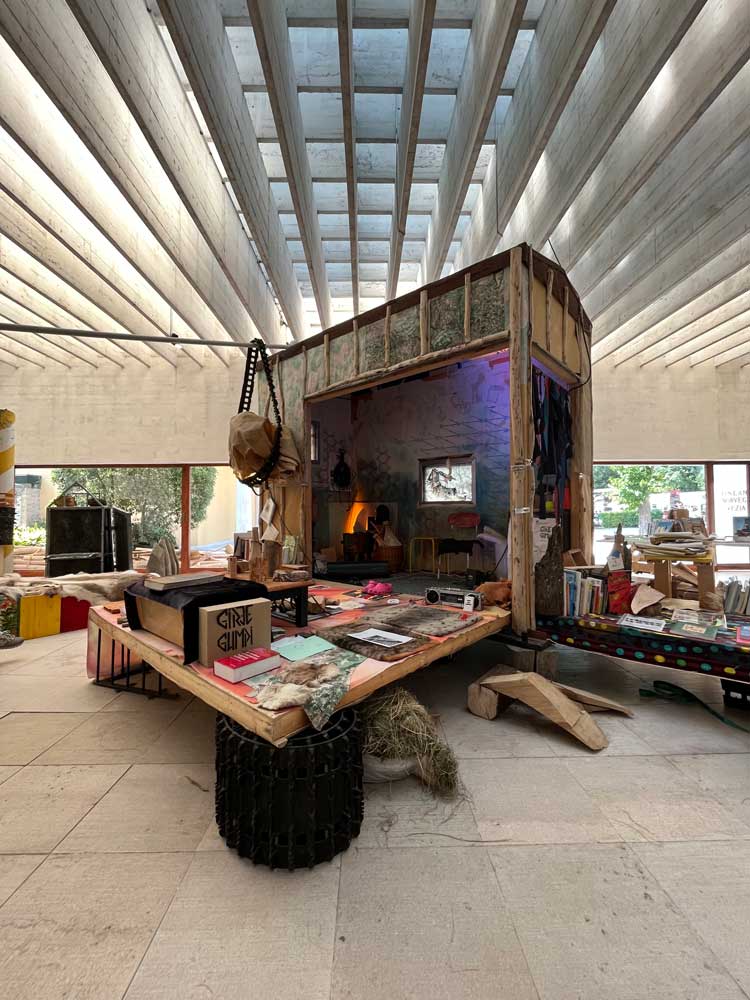
Girjegumpi: The Sámi Architecture Library by Joar Nagno. Photo: Veronica Simpson.
I am also delighted by Girjegumpi: The Sámi Architecture Library, a whimsical and seductive installation by Joar Nagno, filling Sverre Fehn’s modernist structure with seats and shelves and cosy nooks created out of fallen and carved wood, animal pelts and books. And I am tickled and impressed by the Finnish pavilion’s evangelical presentation about dry toilets (but not quite ready to sign up for one myself).
Denmark takes us into a new realm of reimagined coastal landscapes, where industrial wastelands, urban and suburban landscapes and nature might coexist. And Austria brings us step by step through a delightful proposal it had made, to create a staircase over the gardens of the Giardini – which were originally created as a public garden – so that people could come and enter their pavilion free. Both the Venetian and the biennale’s authorities put a stop to it. So, the rear part of the pavilion, where a staircase has been constructed, has been left as an unfinished space. The whole installation reveals the colonising influence of the biennale itself on Venice.
Spain’s pavilion is about food and its role as infrastructure – the systems it supports, and our role in supporting them. It is highly theatrical, using film and overscaled posters and printed material to reveal the forces of extractive capitalism and how they have impacted negatively on animals, as well as soil. Belgium’s pavilion, (Re)Thinking Resources by Bento and Vinciane Despret, is simplicity itself: it promotes mycelium-made panels, with which they constructed a pavilion in the centre, plus the “how to” elements around the edges.
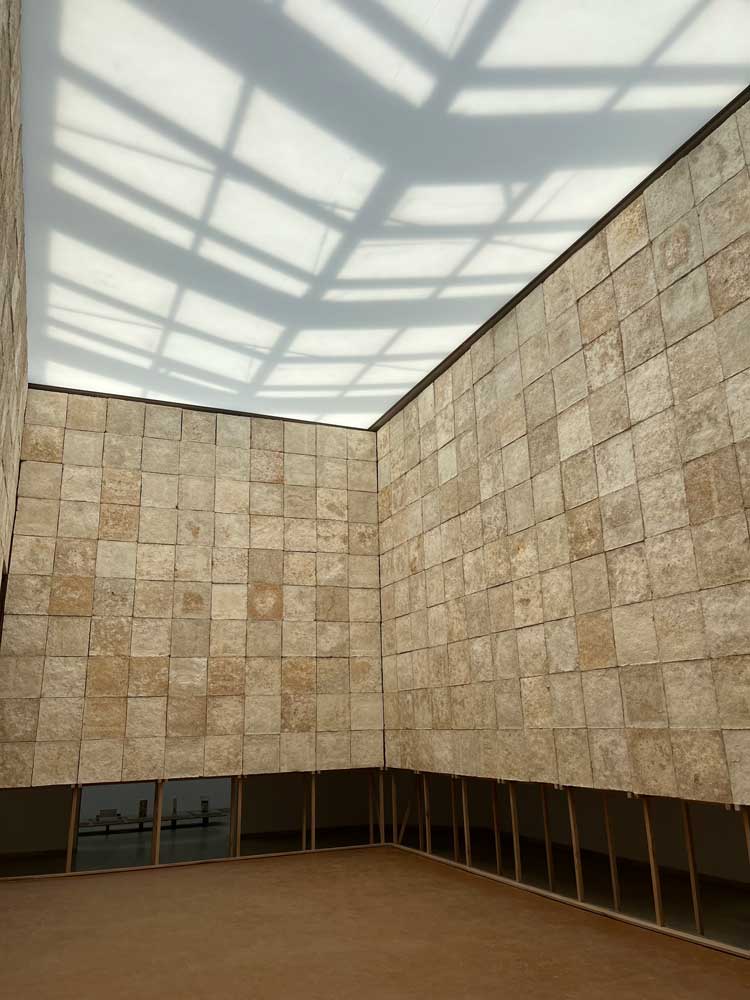
Belgium’s pavilion, (Re)Thinking Resources by Bento and Vinciane Despret. Photo: Veronica Simpson.
And, finally, to the Centrale, the central exhibition space which, given that its selection is under Lokko’s control, could have taken us back into a more coherent exposition of the curatorial vision but, sadly, this time a lot seems to have got lost in translation. The prevailing complaint about not enough architecture rings very true here. The impression is, again, of a dominance of artists over architects. It cannot be that Lokko felt there aren’t enough projects achieved by architects of the global south. She could have dedicated much more space, for example, to the outstanding names who have contributed culturally and climatically appropriate structures to their home continents, such as Marina Tabassum or Francis Kéré (who are present elsewhere, but in a low-key way). They could also have included the significant contribution made to Indian architecture by Le Corbusier’s Indian protege, Balkrishna Doshi, who died in March, aged 95.
Furthermore, I find it puzzling, given this weighting towards artists, that two of the most prominent and successful black artists featured are not celebrated for the amazing architectural and community initiatives they have conjured. Theaster Gates is showing a new film about music, in which he celebrates 10 years of his Black Artist Retreats, an annual event at which musicians from around the world gather together in Chicago. But here is a man who has, almost single-handedly, kick-started the regeneration of Chicago’s Southside through crowdsourced and salvaged construction – building the cultural facilities he felt his community needed, through collective action. If Lokko felt that story is a little too well known in the art community to be featured here, I am sure many of the predominantly young and youngish architects and students whom I see poring over these exhibits would have found it new and inspiring. Likewise, the choice of Ibrahim Mahama. An outstanding artist in his field, he has also repurposed industrial buildings and initiated new structures in northern Ghana, such as his Savannah Centre for Contemporary Arts (SCCA) in Tamale and Red Clay Studio, a multi-acre compound that operates as an open-door education hub for art, technology and engineering. While his Parliament of Ghosts assemblage of salvaged Ghanaian railway furniture is a great installation, an evocation of memory, collapsed industry and colonial ambition, the story of how he has used his work to support his Ghanaian community of “future thinkers”, which is what he wants Red Clay Studio to produce, would surely meet Lokko’s vision head on.
There is, again, a surplus of screens – films about archives, about other conceptual or political issues – basically, more people talking about architecture. So, it is a relief, from that point of view, to find Adjaye’s many models of new and ambitious projects, theatrically lit, showing his extraordinary reach across the globe. It is no wonder that Lokko wants to give her fellow Ghanaian-British high achiever his spotlight – he must be the most successful architect of African origins ever to operate in Europe and the US, as well as elsewhere. But there is very little text or context and no mention, of course, of the fact that many of his new clients run rather problematic regimes of their own.
Overall, as I leave, I confess to feeling disappointed, deflated even. I wondered how the momentum of the Arsenale got diluted and lost. Lokko said in an interview that she wants it to be a laboratory in the sense of “a messy, passionate, argumentative space of deeply human enquiry”.
She has also said she wants it to reflect “the unpredictability of our times”. On both these counts, it succeeds.